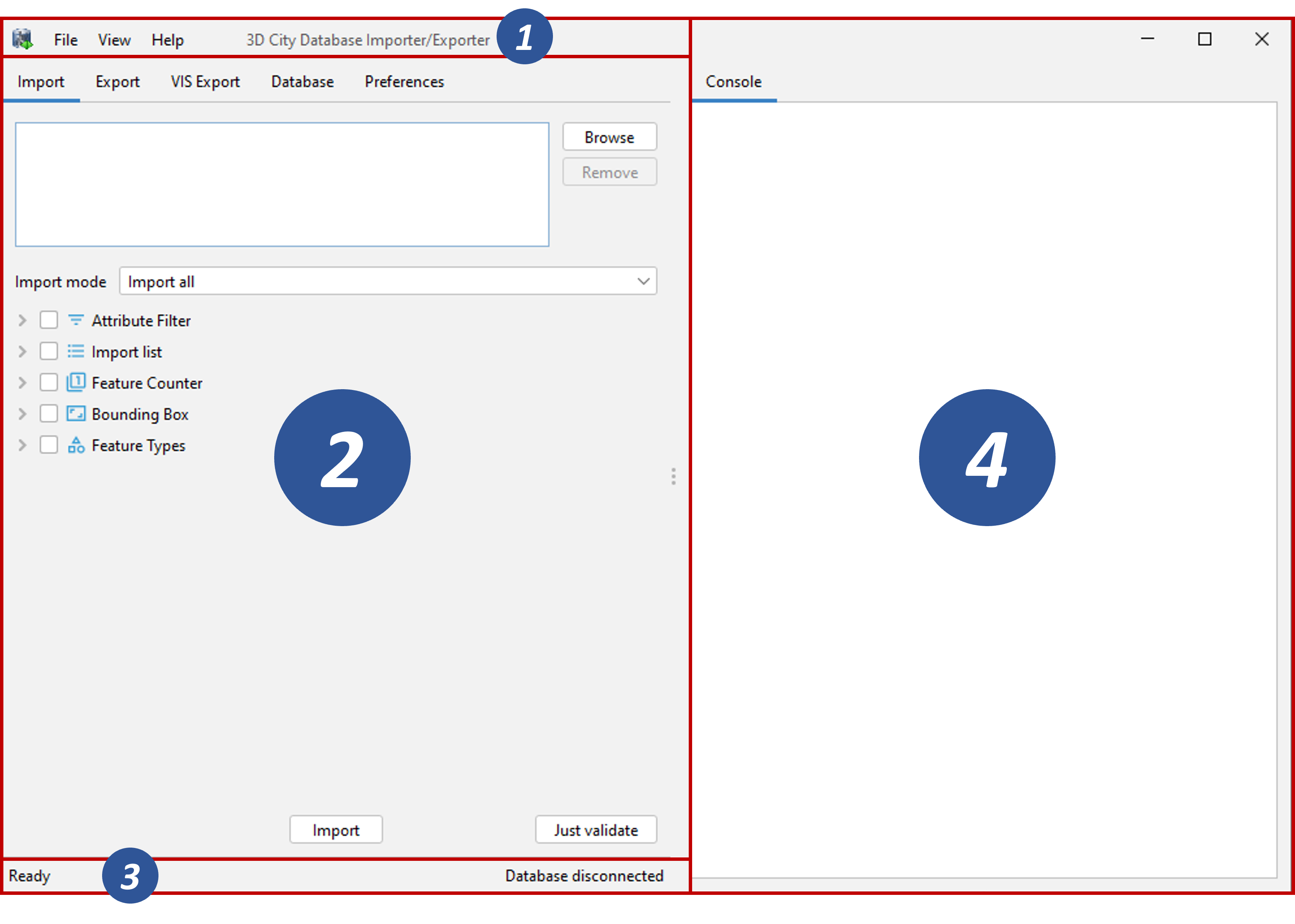4.2. Using the graphical user interface (GUI)¶
The graphical user interface of the Importer/Exporter is organized into four main components as shown in Fig. 4.1. A menu bar [1] is anchored to the top of the window (Windows, some Linux distributions) or to the top of the screen (Mac, some Linux distributions). The main application window is divided into an operations window [2] that renders the user dialogs of the separate operations of the Importer/Exporter and a console window [4] that displays log messages. Via the View entry in the menu bar, the console window can be detached from the main window and rendered in a separate window. At the bottom of the operations window, a status bar [3] provides information about running processes and database connections.

Fig. 4.1 Organization of the Importer/Exporter GUI.
The tab menu on top of the operations window lets you switch between the main operations of the Importer/Exporter and their user dialogs. The following tabs are available:
- Import: Import CityGML or CityJSON datasets into the database
- Export: Export city model data in CityGML or CityJSON format
- VIS Export: Export city model data in KML, COLLADA or glTF format for visualization
- Database: Database connection settings and operations
- Preferences: Preference settings for each operation
Note
If you have installed plugins, the tab menu may contain additional entries. Please refer to the documentation of your plugin in this case. The installed plugins can be managed on the Preferences tab (cf. Section 4.7.1)
The main menu bar [1] offers the entries File, View, and Help. The File menu lets a user store and load application settings from a config file and close the application.
Open Settings…
|
Load a config file and recover all settings from this file.
|
Save Settings
|
Save all settings made in the GUI to the default config file.
|
Save Settings As…
|
Save all settings made in the GUI to a separate config file.
|
Restore Default Settings
|
Set all settings to default values.
|
Save Settings XSD As…
|
Save the XML Schema defining the XML structure of config files to a
separate file. The XML Schema is helpful in case a user wants to
manually edit the config file. Only config files conforming to the XML Schema definition will be successfully loaded by the Importer/Exporter.
|
Recently Used Settings
|
List of recently loaded config files.
|
Exit
|
Close the Importer/Exporter application.
|
The Importer/Exporter uses one default config file per operating
system user running the Importer/Exporter. All settings made in the GUI
are automatically stored in this default config file when the
Importer/Exporter is closed and are loaded from this file upon program
start. The default config file is named project.xml and is stored in the
home directory of the user. Precisely, you will find the config file
in the subfolder 3dcitydb/importer-exporter/config. Note that the
location of the home directory differs for different operating systems.
Using environment variables, the location can be identified dynamically:
%HOMEDRIVE%%HOMEPATH%\3dcitydb\importer-exporter\config(Windows 7 and higher)$HOME/3dcitydb/importer-exporter/config(UNIX/Linux, Mac OS families)
The View menu affects the GUI elements of the Importer/Exporter and offers the following entries:
Open Map Window
|
Open a 2D map window for bounding box selection (cf. Section 4.8).
|
Detach Console
|
Render the console window in a separate application window.
|
Light Mode
Dark Mode
|
Switch between a light and a dark interface style.
|
Restore default perspective
|
Restore the GUI to its default settings.
|
Finally, the Help menu provides a link to the user manual and further information about the Importer/Exporter.
Online-Documentation…
|
Open this user manual in a web browser.
|
Read Me
|
Open README.txt file shipped with the Importer/Exporter.
|
About
|
Display general information like the official version number of the Importer/Exporter and development partners.
|